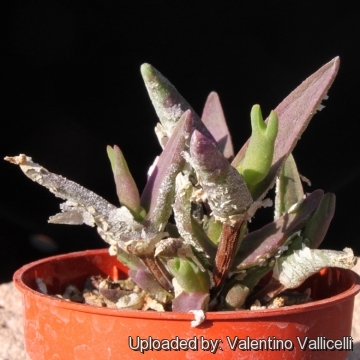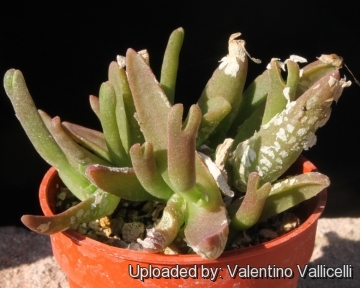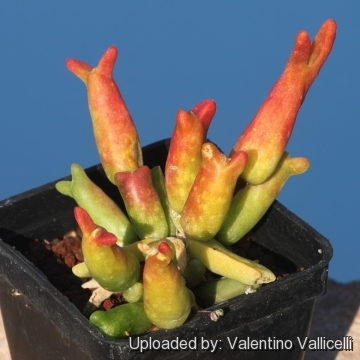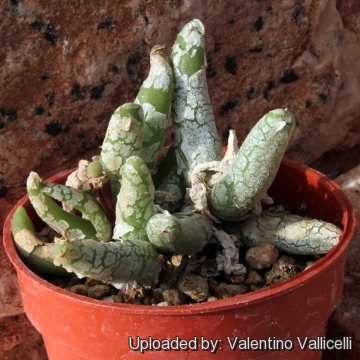
Mitrophyllum abbreviatum Photo by: Valentino Vallicelli
Origin and Habitat: Richtersveld Northern Cape, Namaqualand,South Africa.
Habitat: Southeast-facing slopes in quartz protected by a tangle of other succulent shrubs or rocks.
Synonyms:
Description: Mitrophyllum abbreviatumSN|12099]]SN|12099]] ia a sparingly branched low shrubs with visible nodes up to 20 cm tall. The branches are characteristically covered by dry leaf-remains.
Stem: Short, vertical.
Growth habit Mitrophyllums have a concentrated period of growth, from mid-autumn to mid-winter, and they will flower during this period as well. Mitrophyllums produce two very different leaf-pairs types per season: the "active season pair", only basally connate and free for most of their length, with the upper surface more or less flat, and the "resting season pair", mitre-like (inverted cone shaped), connate for most of heir length with only the tips free, this two types of leaves alternate and are replaced annually. The new leaves develop inside the old coalescent leaf pair. The old leaves redden and dry with proceeding growth of the young leaves until the old ones are reduced to a thin sheet of dry matter that protects next season's growth during the summer resting phase. Leaf growth ceases at this stage.
Blooming season: Late winter. This species flowers when young and is one the best species for horticulture.
 Mitrophyllum abbreviatum Photo by: Valentino Vallicelli
Mitrophyllum abbreviatum Photo by: Valentino Vallicelli Mitrophyllum abbreviatum Photo by: Valentino Vallicelli
Mitrophyllum abbreviatum Photo by: Valentino Vallicelli Mitrophyllum abbreviatum Photo by: Valentino Vallicelli
Mitrophyllum abbreviatum Photo by: Valentino Vallicelli Mitrophyllum abbreviatum Photo by: Valentino Vallicelli
Mitrophyllum abbreviatum Photo by: Valentino Vallicelli Mitrophyllum abbreviatum Photo by: Valentino Vallicelli
Mitrophyllum abbreviatum Photo by: Valentino Vallicelli - Augrabies, Little Namaqualand, North-West Cape Province, South Africa (MG 1779.32) Photo by: Valentino Vallicelli
- Augrabies, Little Namaqualand, North-West Cape Province, South Africa (MG 1779.32) Photo by: Valentino Vallicelli Mitrophyllum abbreviatum Photo by: Valentino Vallicelli
Mitrophyllum abbreviatum Photo by: Valentino Vallicelli Mitrophyllum abbreviatum Photo by: Valentino Vallicelli
Mitrophyllum abbreviatum Photo by: Valentino VallicelliCultivation and Propagation: They are relatively difficult to grow and take many years to mature. In cultivation the plants tend to be fall and winter active and head for summer dormancy. The growing season in northern hemisphere is from September to March, but the active growth is concentrated in a short period in early autumn.
Soil: They prefer sandy, mineral-rich soil and require a very good drainage and protection from excessive water.
Fertilizer: Be careful not to apply too much fertilizer.
Water: Water minimally in summer. Water regularly in winter after the new green leaves appears at their extremities in autumn after the summer resting period, or alternatively (as for other difficult species) do not to water the plants themselves, but sink the pots in gravel which is kept moist.
Exposure: They enjoy some shade (avoid direct summer sun as they grow wild among rocks and under the shade of other plants) and in summer they need to be kept in a cool area.
Hardiness: Hardy to -2°C (or less).
Maintenance: Avoid to repot frequently. This plant may stay in the same pot for many years. Plants grown in larger containers have frequently relatively poor flowers. It might improve when the plants are given their own, small individual pots. Ensure a very good ventilation.
Propagation: They can be reproduced by seed and with much less ease from cuttings. Take the cutting from a grown-up mother plant. Each cutting must contain one or more branches along with a fraction of root.


















